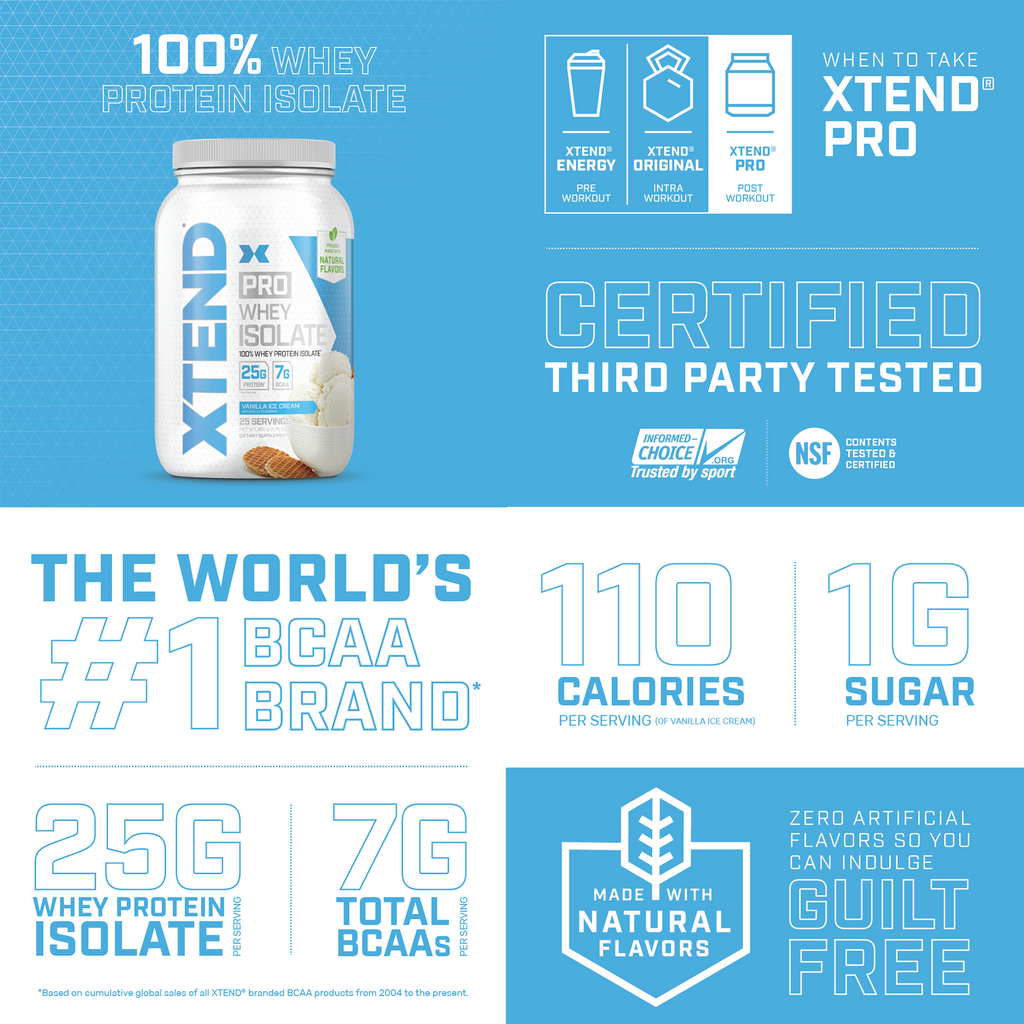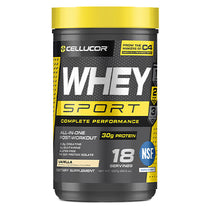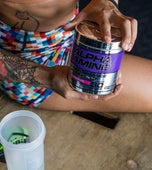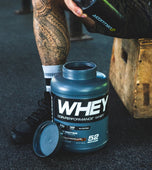By: Matt Gaston Villanueva, Ph.D.
When it comes to protein—one of the three main macronutrients alongside carbohydrates and fat, and a very important one at that, physiologically speaking—let’s get one thing straight, upfront: not all sources are created equal.
For me, protein is all about quality, especially when it comes to choosing the best protein sources for you and your body. In my opinion, the whey protein simply gets the job done far better than many other types of proteins.
Whey protein contains the full range of essential amino acids (EAAs) in abundance, making it a high-quality complete protein.

Furthermore, whey protein is broken down, assimilated, and utilized relatively quickly by the human body, and numerous research studies have produced strong scientific evidence that whey protein supplementation can help you increase muscle mass and enhance muscle performance—including strength, power, and endurance—and help facilitate fat loss.

Whey protein is one of the most well-studied supplements in the world. In this detailed article all about protein and specifically whey protein, I'll dive deeper into what whey protein is, how it works, and how to use whey protein for your health and fitness goals—covering everything from dosing, timing, and a few other need-to-know aspects of this extremely versatile supplement.
What is whey protein?
Whey protein is a mixture of proteins isolated from whey, which is the liquid part of milk that separates during the production of cheese.
Milk actually contains two main types of protein, which you’ve likely heard of before: casein, which accounts for roughly 80% of milk protein, and whey, which is the other 20%.
Specifically, whey is found in the watery portion of milk. When making cheese, the fatty parts of milk coagulate, and the whey is separated from it as a byproduct. We’ve all probably opened a fresh yogurt container to see liquid sitting on top—yes, that’s whey.
After being separated during cheese production, whey goes through a series of steps during processing to ultimately become what many of us recognize as our favorite supplement: a flavored protein-rich powder.

In general, a serving of whey protein packs approximately 20-27 grams of high-quality complete protein, making it an extremely convenient (and cost-effective) way to hit your daily protein intake.
Keep in mind, 4 ounces of grilled chicken breast contains roughly 24 grams of protein, with a similar amount of fat and carbohydrate compared to quality whey protein powders.
In addition, supplementing with a high-quality whey protein powder can be a game-changer for athletes, bodybuilding, and other physique competitors, training and lifting enthusiasts, and any other individual who may require a relatively high daily intake of (complete) protein in order to optimize muscle performance and recovery.
Similarly, it’s a very useful addition to a holistic nutritional regimen for those who find they are simply deficient in protein through their normal daily diet.
The Importance of Whey Protein
First and foremost, proteins are the main building blocks of the human body, utilized to generate organs, hormones, enzymes, neurotransmitters, connective tissues (e.g., tendons that attach muscle to bone), and various other molecules. Proteins are also the building blocks of human muscle and make up the elements that facilitate muscle contractions (i.e., human movement).
Protein molecules are assembled from amino acids, which are even smaller molecules linked together in a specific sequence like beads on a string. While certain amino acids are naturally produced by our body’s cells, referred to as non-essential amino acids, others must be supplied to our bodies through the food we consume. These are referred to as essential amino acids, or the EAAs I referenced earlier.

Whenever I think of the best high-quality sources of protein, I think of proteins that provide all nine essential amino acids, and, yep, whey protein is loaded with all of the EAA’s. Whey protein is particularly high in three crucial EAAs, known as the branched-chain amino acids, or BCAAs, which are leucine, isoleucine, and valine.
Strong scientific evidence indicates that the EAAs—and especially leucine and the other BCAAs—promote tissue anabolism (i.e., muscle growth) and tissue regeneration. Longitudinally, this acute effect has the power to enhance recovery and to augment, and even optimize, muscle growth, and performance.
Uses for whey protein
All this being said, the most common use of a whey protein supplement is to promote protein synthesis and support hypertrophy, or muscle growth, and improve long-term muscle performance qualities like strength and power.
Intelligent whey protein supplementation has essentially become a “staple” in the nutritional strategies of performance- and results-driven athletes like bodybuilders, strength athletes, CrossFitters, and many others.
How does whey protein work?
Here are some of the primary ways that the ingestion of whey protein can stimulate muscle growth and muscle performance enhancements:
- As previously discussed, whey protein delivers all the amino acids and building blocks that are required for anabolism (i.e., muscle growth). And, a bigger muscle, given myofibrillar hypertrophy, has even more potential to be a stronger and more powerful muscle.
- Protein timing is a popular nutritional strategy designed to optimize the adaptive responses to training—specifically lifting, or resistance training. This strategy oftentimes involves consuming whey protein around your training sessions (i.e., pre- and/or post-training) in an effort to facilitate, maximize, and optimize muscle repair and remodeling and, thereby, augment long-term muscular/functional performance adaptations. This effect is also linked to the BCAA leucine, and numerous studies suggest that leucine stimulates skeletal muscle protein synthesis at the molecular level.
- One of the biggest reasons I love whey protein as a peri-training supplement (i.e., to ingest pre- and/or post-training) is because it is digested, absorbed, and utilized by the body relatively fast, especially when compared to other types of protein.
In addition to its promise as a supplement that can help us build muscle, accelerate increases in performance, and maintain the hard-earned lean tissue mass we currently carry, whey protein can also help people lose body fat.

More than the other macronutrients, protein helps promote satiety and boost energy expenditure via the thermic effect of food, or the calorie cost of digesting and processing protein itself. Whey protein has been shown to aid weight loss by reducing appetite in between meals.
In the context of a nutritional approach that includes decreased amounts of carbohydrates and/or fats, whey protein can serve as a macronutrient that “bridges the gap” from a caloric standpoint and help an individual meet their daily protein intake requirement, keep their anabolic switch flipped up, and avoid negative impacts to muscle performance and training/work output and capacity.
How much whey protein per day?
Your personal protein daily protein intake depends on a variety of factors, including your training regimen (i.e., frequency, intensity, volume, and methodology), fitness level, and trained state.
In general, a range of total daily protein intake from as low as 0.8 grams per pound of bodyweight to as high as 1.4 grams per pound of bodyweight. Many people find it easy to target the middle of that range or roughly 1 gram of protein per pound of bodyweight.
How much whey protein you use depends in part on your daily protein target and the composition of your diet. I commonly recommend using at least one serving (roughly 25 grams) of whey per day for women and two servings (50 grams) for men.

This amount will vary for each individual.
When should I take whey protein?
You can take whey protein at any time of day, but is especially ideal when:
- Nutrient timing is a priority and you want to ingest a fast-absorbing protein source, like before or after a workout.
- You're on the go and want a convenient, clean source of protein.
- You want to mix up your protein sources to promote adherence, sustainability, and enjoyment of your diet.
How many protein shakes should you have a day?
It is generally recommended to consume 1-2 scoops (25g-50g) per day, usually post-workout, but you could drink as many as five protein shakes a day.
- Upon waking, as an easy go-to breakfast.
- With your first solid meal of the day to boost protein content.
- Roughly 60 minutes before you lift.
- After resistance training, ideally immediately or up to 2 hours post-lift.
- Late-evening snack to “cap off” your protein intake for the day.
Types of whey protein
You now know the myriad benefits of whey protein, which extend from helping support muscle growth to helping you lose fat.
It's important to consider that there are a few main types of whey protein you’ll discover on the market, and we’ll talk about the difference between whey concentrate, isolate, and hydrolysate.
Their main difference is in total protein content and the way they have been processed:
- Whey Protein Concentrate (WPC): Roughly 70 to 80% protein. Typically contains some lactose and has a relatively low amount of fat and carbohydrate.
- Whey Protein Isolate (WPI): Typically, 90% protein by weight, sometimes higher. WPI usually contains less lactose and fat compared to concentrate, with very low amounts of carbohydrate. Digested and utilized even faster than whey protein concentrate.
- Whey Protein Hydrolysate (Hydrolyzed Whey Protein): This type of whey protein has been further broken down through processing so that it can be absorbed and delivered to your body rapidly.
Keep in mind that many whey protein products consist of multiple types of whey protein (such as a whey protein concentrate and whey protein isolate blend), and each product will deliver a different quantity of each type. For this reason, it's important to check the nutrition label before investing in a certain whey protein supplement.
Overall, the best whey protein supplements will deliver 25 grams of complete protein per serving, minimal fat and carbohydrate content, and an enjoyable flavor!
My absolute favorite, which is a 100% pure whey protein isolate with 7 grams of added branched-chain amino acids, is XTEND Pro.
Other types of protein
While whey protein is a great go-to protein for many people and good for you, there are several other protein supplements made from other sources on the market.
While these other sources don't support muscle growth as directly as whey due to different absorption speeds and amino acid content, they can be highly beneficial and useful for other reasons.
Casein Protein
Similar to whey protein, casein is a protein found in milk. However, unlike whey, casein is digested and absorbed at a much slower rate. The reason behind this is because, upon ingestion, casein forms a “gel” when it interacts with the acid in your stomach. This slows down gastric/stomach emptying time and delays the rate at which this protein’s amino acids are absorbed.
At the muscle tissue level, consumption of a casein protein results in a very steady and prolonged delivery of amino acids, which can still stimulate muscle protein synthesis (like whey protein can), but at a slower rate and, as evidence suggests, to a lesser degree than whey protein.
Due to the more gradual absorption and delivery of amino acids to your body/muscle tissue, when supplementing with a casein protein, I strongly recommend casein products be taken pre-bedtime, which will expose your muscles to amino acids across an extended period of time (i.e., sleep).
Use whey throughout the day and casein before bed to get the best of both worlds!
Egg Protein
Similar to other animal products, like chicken and beef, eggs are a complete protein source, providing all nine essential amino acids.
In addition, egg protein is second in line—only to whey protein—as a complete protein with the highest leucine content, a crucial branched-chain amino acid (BCAA) that that is a key contributor to muscle growth, muscle tissue remodeling, and regeneration, and muscle performance.
Egg (white) protein products are a good choice to take in conjunction with whey or for anyone who experiences allergic reactions to dairy.
Vegetarian Protein
The boom in protein supplementation over the last several years has led to more vegetarian and vegan options than ever.
While I recommend whey protein for those without dietary restrictions due to its numerous physique- and performance-supporting qualities, plant proteins are great options for vegan, vegetarians, those with dairy allergies, and others.
The most common plant-based protein supplements are pea protein, hemp protein, rice protein, and blended plant proteins.
Each one of these proteins has unique qualities—for example, pea protein is high in leucine compared to other plant proteins, while hemp protein contains omega-6 and omega-3 fats in an ideal 3:1 ratio—so I'd recommend researching each type in greater detail if you want to supplement with a plant-based protein for any reason.
Plant proteins may contain minerals and fiber, so they can be both healthful and filling. Because of their fiber content and the amount of material needed to reach a certain protein level, plant proteins may be higher in calories per serving than some of their animal counterparts.
As for taste, while many plant proteins aren't quite as delicious as whey protein shakes yet, there are plenty of tasty options available.
Whey Protein Safety & Things to Keep in Mind
Concerns about protein causing health dangers, such as kidney damage and contributing to osteoporosis, are unwarranted. In fact, protein has been scientifically shown to protect against osteoporosis, while having no impact on healthy kidneys.
It is important to note, however, that people with current kidney or liver issues may want to consult with a medical professional and highly experienced nutritionist prior to commencing any supplementation regimen.
From my personal and professional experience, ingesting too much protein at once can potentially cause digestive issues, such as stomach upset and/or cramping. If you stick to my recommendations on dosing, timing, and choose a high-quality whey protein isolate like XTEND Pro, then you shouldn't have any issues.
Lastly, while whey protein has an excellent safety profile, and most people can incorporate it daily into their supplementation/nutrition regimens, it's important to note that some individuals are allergic to whey.
So, if you can’t tolerate any type of whey protein (concentrate, isolate, or hydrolysate), you may need to avoid whey protein and opt to eat other protein-rich whole foods or supplements like those outlined above.
For anyone taking a supplement, particularly competitive athletes, it's critical to know that what's on the label of any product is what's in the bottle. Thankfully, there are reputable third-party certification programs, like Informed-Choice, that test products at multiple levels on an ongoing basis.
Informed-Choice is a quality assurance program for sports nutrition products, suppliers to the sports nutrition industry, and supplement manufacturing facilities. It is a monitoring program that certifies that a supplement product or raw material that bears the Informed-Choice logo has been “skip-lot” tested (tested at least on a monthly basis) for banned substances by a world-class sports anti-doping lab.
Supplement users can use the search function at the Informed-Choice website to find products like XTEND Pro that have been through this certification process.
The Informed-Choice certification is a voluntary program for reputable supplement companies who wish to register some, or all, of their products and carry the Informed-Choice mark on those products.
Above all, athletes who see the Informed-Choice logo on a product can be assured it has undergone rigorous checks and testing to ensure that it is not contaminated with banned substances and is even safer to use.
Cooking with Whey Protein
Yes, you can absolutely cook with whey protein!
Spurred by innovative chefs, better protein flavors, and dietary strategies like flexible dieting, cooking with whey has become increasingly popular over the last several years. Even our athletes have shared their favorite protein recipes!
The nice thing about whey is that it's incredibly versatile: you can simply mix it with water or milk, add fruit and other ingredients to make a simple smoothie, or go all-out and try new recipes online.
XTEND Pro Recipes
Pancakes:
Chocolate Peanut Butter Cup Protein Pancakes
Cookie Butter Protein Pancakes
Salted Caramel Chocolate Chip Protein Pancakes
Cookies & Cream Protein Pancakes
Cookie Butter & Jelly Protein Pancakes
Waffles:
Blueberry Almond Protein Waffles
Breakfast Treats:
Double Chocolate Protein Donuts
Brownie Batter Protein Oatmeal
Caramel Apple Slow Cooker Proats
PB&J Cookie Butter Protein Cereal Treats
Cookie Butter & Jelly Flex Bowl
Desserts:
No-Bake Salted Caramel Protein Cheesecake
Double Chocolate Protein Peanut Butter Cups
Cookie Butter & Jelly Protein Mug Cake
Vanilla Peanut Butter Protein Cupcakes
Cookie Butter Protein Milkshake
Salted Caramel + Chocolate Protein Bars
Cookie Butter Protein Cookie Dough
Keto Low Carb Chocolate Avocado Protein Pudding
Peanut Butter Stuffed Blueberry Protein Cupcakes
S'mores Stuffed Protein Cookie Cake
Giant Protein Oatmeal Cream Pie
Your New Favorite Protein: XTEND PRO
These days, this is an easy one! You’ve probably already guessed it, but one of my true all-time favorites is XTEND Pro.
My go-to times to take XTEND Pro are in the morning, either right when I wake up or after some work, after a lifting workout, and with any solid food meal such as oatmeal to add a complete protein source.
As a male who sits around 200 pounds, my typical single shake dose is 2-2.5 servings, which leaves me feeling full, satisfied, and, well, happy!
You really can't go wrong with any flavors, but the two XTEND Pro flavors that I absolutely fell in love with, right out of the gate, are Chocolate Lava Cake and Cookie Butter.
One is an indulgent mix of midnight cocoa and molten chocolate, while the other is a blend of crushed peanut, sweet butter cookies, with a hint of spice. I always mix and match to keep my sweet tooth satisfied, and I suggest you keep a few favorites in rotation to help you hit your personal goals!
XTEND Pro is a 100% whey protein isolate that tastes incredible, includes extra BCAAs in each serving, and has a really clean profile for each flavor.
You could say it's the gold standard of protein.

Author Bio
Dr. Matt Villanueva is all about "walking his talk," by living a very fit lifestyle, leading by example, and striving to guide you on how to do so too. Dr. Matt is a graduate of the University of Southern California (Los Angeles, CA), where he earned his Ph.D. in Biokinesiology with an exercise science emphasis.
As owner and director of the V-Fit Premier Fitness and Wellness Institute in Tulare, California (vfitbydrmatt.com), Dr. Matt brings over 11 years of high-level education and over 14 years of applied, hands-on work experience with a diverse range of hundreds and hundreds of clients to V-Fit and the holistic fitness, athletic performance, health, and wellness industry, primarily in the fields/areas of: exercise science and applied exercise physiology, exercise prescription and strength and conditioning for individuals across the lifespan, athletic performance/sport-specific training, bodybuilding and physique development training, nutrition for performance and health and wellness, and healthy aging.
Selected References and Further Reading
Scientific Publications
The Effects of Beef, Chicken, or Whey Protein After Workout on Body Composition and Muscle Performance
Sharp et al. (2018)
https://insights.ovid.com/pubmed?pmid=28399016
Effect of whey protein supplementation on body composition changes in women: a systematic review and meta-analysis
Bergia et al. (2018)
https://insights.ovid.com/crossref/01434664-201807000-00006?isFromRelatedArticle=Y
Effects of protein supplements consumed with meals, versus between meals, on resistance training-induced body composition changes in adults: a systematic review
Hudson et al. (2018)
https://insights.ovid.com/crossref/01434664-201806000-00005?isFromRelatedArticle=Y
A systematic review, meta-analysis and meta-regression of the effect of protein supplementation on resistance training-induced gains in muscle mass and strength in healthy adults
Morton et al. (2018)
https://insights.ovid.com/crossref/00002412-201803150-00009?isFromRelatedArticle=Y
Effects of Protein Supplementation in Older Adults Undergoing Resistance Training: A Systematic Review and Meta-Analysis
Finger et al. (2015)
https://insights.ovid.com/crossref/00007256-201502000-00008?isFromRelatedArticle=Y
International Society of Sports Nutrition Position Stand: protein and exercise
https://jissn.biomedcentral.com/articles/10.1186/s12970-017-0177-8
International Society of Sports Nutrition Position Stand: diets and body composition
https://jissn.biomedcentral.com/articles/10.1186/s12970-017-0174-y
The Rundown on Protein: Your Questions Answered!
Layne Norton (2018)
https://www.bodybuilding.com/fun/layne42.htm





















